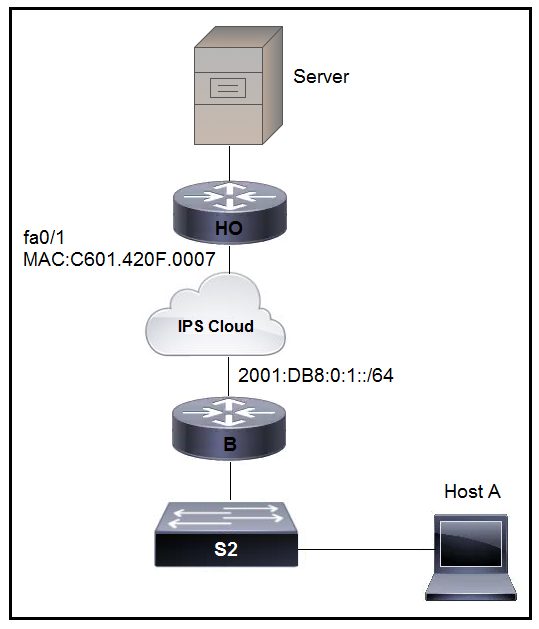
Refer to the exhibit. An engineer is configuring the HO router. Which IPv6 address configuration must be applied to the router fa0/1 interface for the router to assign a unique 64-bit IPv6 address to itself?

Refer to the exhibit. An engineer is configuring the HO router. Which IPv6 address configuration must be applied to the router fa0/1 interface for the router to assign a unique 64-bit IPv6 address to itself?
To assign a unique 64-bit IPv6 address, the EUI-64 format is typically used to automatically generate an interface identifier from the MAC address. The MAC address provided is C601.420F.0007. Using the EUI-64 process, we split the MAC address and insert 'FFFE' in the middle, forming C601:42FF:FE0F:0007. The correct IPv6 address for the FA0/1 interface, using the EUI-64 format, should be 2001:DB8:0:1:C601:42FF:FE0F:7/64, which matches option C.
LETTER C IS THE CORRECT ANSWER although IPv6 SLAAC (EUI-64) process is missing: 48 bit MAC Address = C6-01-420F:0007 split address in the middle = C6-01-42 0F-00-07 insert FF:FE = C6-01-42-FF:FE-0F-00-07 hexadecimal = C"6"-01-42-FF:FE-0F-00-07 7th bit in binary = 6 = 0000 0110 7th bit flip changes 6 to 4 = 0000 0100 64 bit host interface ID = C401:42FF:FE0F:0007 LETTER C IS THE CORRECT ANSWER so, ipv6 address 2001:DB8:0:1:C601.42FF:FE0F:7 /64
The correct answer here should be C even though the 7th bit was not inverted. The other options are no good.
Extremely POOR QUESTION! Reading the question, you are actually asked to provide a configuration to the router's Fa 0/1 interface so it assigns a unique address. None of these answers are correct - for different reasons as discussed. The command should be: ipv6 address 2001:DB8:0:1:/64 eui-64 End of discussion. The question is trying to apply a static GUA to simulate modified EUI-64 Why don't they say that!
it's C with ipv6 address 2001:DB8:0:1:C401:42FF:FE0F:7/64
Considering that the interface MAC address is c601.420F.0007 and we are interested in using EUI-64 format for the interface identifier, the correct IPv6 address configuration for the fa0/1 interface would be: ipv6 address 2001:DB8:0:1:C601:42FF:FE0F:7/64 This configuration uses the EUI-64 format, where FFFE is inserted in the middle of the MAC address c601.420F.0007 to create the interface identifier. The resulting IPv6 address is based on the modified MAC address. So, the correct option is: C. ipv6 address 2001:DB8:0:1:C601:42FF:FE0F:7/64
IPv6 hosts and routers can calculate their own link-local address, for each interface, using some basic rules. First, all link-local addresses start with the same prefix, as shown on the left side of Figure 24-9. By definition, the first 10 bits must match prefix FE80::/10, meaning that the first three hex digits will be either FE8, FE9, FEA, or FEB. However, when following the RFC, the next 54 bits should be binary 0, so the link-local address should always start with FE80:0000:0000:0000 as the first four unabbreviated quartets. So the answer has to be C but it's also wrong because of 7th bit.
I think they are asking for EUI 64 so FFFE should be in the ipv6 config
Horrible question the answer is C add FFFE in the middle of the MAC and flip the 7th bit is how to obtain the EUI-64 Address
The letter C is correct, the flip of the 7th bit is only necessary when it is 0
Correct answer is C
Time wasting question all are good. I would have made my live simple and used 2001:DB8:0:1::1/64. None of the answers are unique local so we have to assume it is unique global and thus chosen by the admin.
it´s C
t looks like there might be an error in the exhibit or options provided, as there is no information about the prefix or network details. However, I can guide you on how to configure a unique IPv6 address on the fa0/1 interface. In IPv6, the EUI-64 process is commonly used to derive the interface identifier (64 bits) from the 48-bit MAC address. The MAC address is modified to insert "FFFE" in the middle, and the seventh bit is flipped. This process helps create a unique identifier. ipv6 address 2001:DB8:0:1:C601:42FF:FE0F:7/64
C is the close but not correct for me We have to flipt 7th bit of network portition You can check the answer in this web site. https://eui64-calc.princelle.org/ https://www.calcip.com/eui-64/C6-01-42-0F-00-07 2001:DB8:0:1:C401:42FF:FE0F:7 but i am confused about this information. it says about 7th bit stays 1 if it is global adres is the address is globally unique. Next, the seventh bit from the left, or the universal/local (U/L) bit, needs to be inverted. This bit identifies whether this interface identifier is universally or locally administered. If 0, the address is locally administered and if 1, the address is globally unique. ...... https://ciscoexam.online/CCNP/300-101/413
The Universal/Local (U/L) bit, which is the 7th bit of the MAC address, plays a specific role in this process. Here's how the U/L bit is used in EUI-64 format: If the U/L bit is set to 0 (indicating a globally unique MAC address), it is inverted to 1 in the EUI-64 format. If the U/L bit is set to 1 (indicating a locally administered MAC address), it remains 1 in the EUI-64 format. So the only plausible way is that one or the answer is incorrect.
B is correct
the correct answer is C split into two and add FF FE into it and the invent the 7th bit if its 1 to 0 or if its 0 to 1